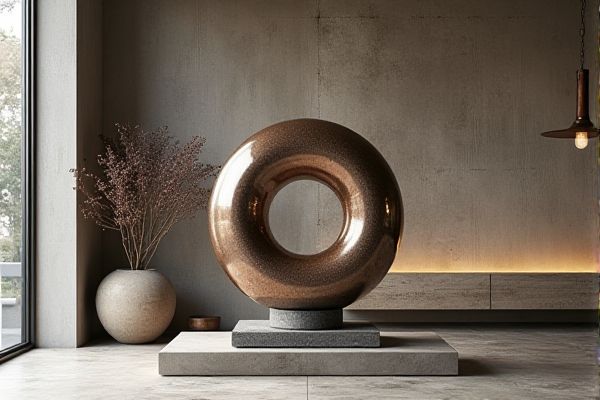
Metal sculpture offers greater malleability and allows for intricate, dynamic forms that can capture movement and light in unique ways, while stone sculpture provides a timeless, solid presence with a natural texture and durability that often conveys a sense of permanence. Discover how understanding the distinct qualities and techniques of metal and stone sculptures can enhance your appreciation of these art forms by reading the rest of the article.
Table of Comparison
| Aspect | Metal Sculpture | Stone Sculpture |
|---|---|---|
| Materials | Bronze, steel, aluminum, copper | Marble, granite, limestone, sandstone |
| Durability | High; resistant to weather, corrosion varies by metal | Very high; resistant to weather and time, can erode |
| Weight | Generally lighter than stone | Heavier, denser material |
| Workability | Can be welded, cast, or assembled; flexible design | Carved and chiseled; requires precision and time |
| Surface Texture | Smooth, polished, or varied finishes | Rough, chiseled, or polished |
| Cost | Varies; metal casting can be expensive | Generally costly due to labor and stone quality |
| Common Uses | Outdoor statues, abstract art, modern designs | Monuments, traditional statues, architectural details |
| Maintenance | Requires protection against rust and corrosion | Needs cleaning; less prone to corrosion |
Introduction to Metal Sculpture and Stone Sculpture
Metal sculpture involves shaping and assembling materials such as bronze, steel, and aluminum to create dynamic, often intricate forms with a modern aesthetic and high durability. Stone sculpture, traditionally crafted from marble, granite, or limestone, emphasizes carving and chiseling to reveal timeless, textured artworks with historical and cultural significance. Both mediums offer distinct tactile and visual experiences, with metal enabling fluid shapes and stone providing solid, enduring presence.
Historical Evolution of Metal and Stone Sculptures
Metal sculpture originated prominently during the Bronze Age, with civilizations like the ancient Greeks and Romans advancing techniques such as lost-wax casting to create intricate and durable art forms. Stone sculpture dates back to prehistoric times, with early humans carving petroglyphs and statues from limestone and marble, evolving through classical periods into monumental works like Michelangelo's David. The historical evolution of metal and stone sculptures reflects technological advancements, cultural shifts, and material availability influencing artistic expression across centuries.
Material Properties: Metal vs. Stone
Metal sculptures exhibit high tensile strength, malleability, and the ability to capture fine details through casting or welding, allowing for dynamic forms and intricate designs. Stone sculptures possess inherent durability, compressive strength, and a natural texture that provides a timeless, solid appearance but requires subtractive techniques like carving. Differences in thermal expansion and resistance to weathering also influence the longevity and maintenance of metal versus stone artworks.
Techniques and Tools Used in Both Mediums
Metal sculpture techniques involve welding, casting, and forging, utilizing tools such as welders, anvils, and blowtorches to shape and join metal pieces. Stone sculpture relies on chiseling, carving, and polishing, with tools including hammers, chisels, rasps, and diamond-tipped saws to carefully remove material and refine surfaces. Your choice between these mediums will influence the tools you master and the techniques best suited to your creative vision.
Durability and Maintenance of Metal vs. Stone Sculptures
Metal sculptures, often crafted from bronze, steel, or aluminum, generally exhibit superior durability against impact and weathering compared to stone, which is prone to chipping and erosion over time. Stone sculptures, particularly those made from marble or limestone, require regular maintenance to prevent surface degradation caused by acid rain and biological growth. Protective coatings such as wax for metal and sealants for stone are essential to extend lifespan and preserve aesthetic quality in outdoor installations.
Artistic Expression and Aesthetic Differences
Metal sculpture offers dynamic possibilities through malleability and the interplay of light on reflective surfaces, allowing for intricate details and fluid forms that convey movement and modernity. Stone sculpture emphasizes solidity and timelessness with its natural textures and weight, creating a sense of permanence and classical beauty that engages viewers with tactile, raw materiality. Your artistic expression can thrive uniquely in each medium, with metal enabling bold, abstract designs and stone fostering traditional, monumental aesthetics.
Applications and Popular Locations
Metal sculptures are prominently used in urban public spaces, parks, and modern architectural designs due to their durability and ability to capture intricate details, making them ideal for interactive installations and contemporary art. Stone sculptures, favored for their timeless aesthetic and weather resistance, commonly adorn historical landmarks, religious sites, and garden landscapes, serving as durable monuments or classical art pieces. Both mediums are integral to cultural heritage and modern art, with metal preferred for innovation and dynamic forms, while stone is chosen for permanence and traditional significance.
Environmental and Cost Considerations
Metal sculpture production often involves higher energy consumption and emissions due to metal extraction and smelting processes, while stone sculpture relies on quarrying, which can cause significant habitat disruption. Cost-wise, metal sculptures generally require more expensive raw materials and specialized fabrication techniques, whereas stone sculptures may incur higher labor costs due to intensive hand carving. Both mediums have distinct environmental impacts and budget implications that influence artistic and commercial decisions.
Notable Artists and Iconic Works
Metal sculpture features notable artists like Alexander Calder, renowned for his dynamic mobiles, and Richard Serra, famous for massive steel structures such as "Tilted Arc." Stone sculpture highlights Michelangelo, whose masterpiece "David" exemplifies Renaissance artistry, and Rodin, celebrated for expressive works like "The Thinker." Your appreciation of these mediums can deepen by exploring their iconic pieces and the distinct techniques each artist employed.
Choosing Between Metal and Stone for Sculpture
Choosing between metal and stone for sculpture depends on factors such as durability, texture, and artistic style. Metal sculptures offer flexibility with various finishes and structural strength, ideal for intricate or large-scale works, while stone sculptures provide a timeless, natural aesthetic with a sense of permanence and weight. Your decision should consider the environment where the sculpture will be displayed and the level of detail you wish to achieve.
 homyna.com
homyna.com